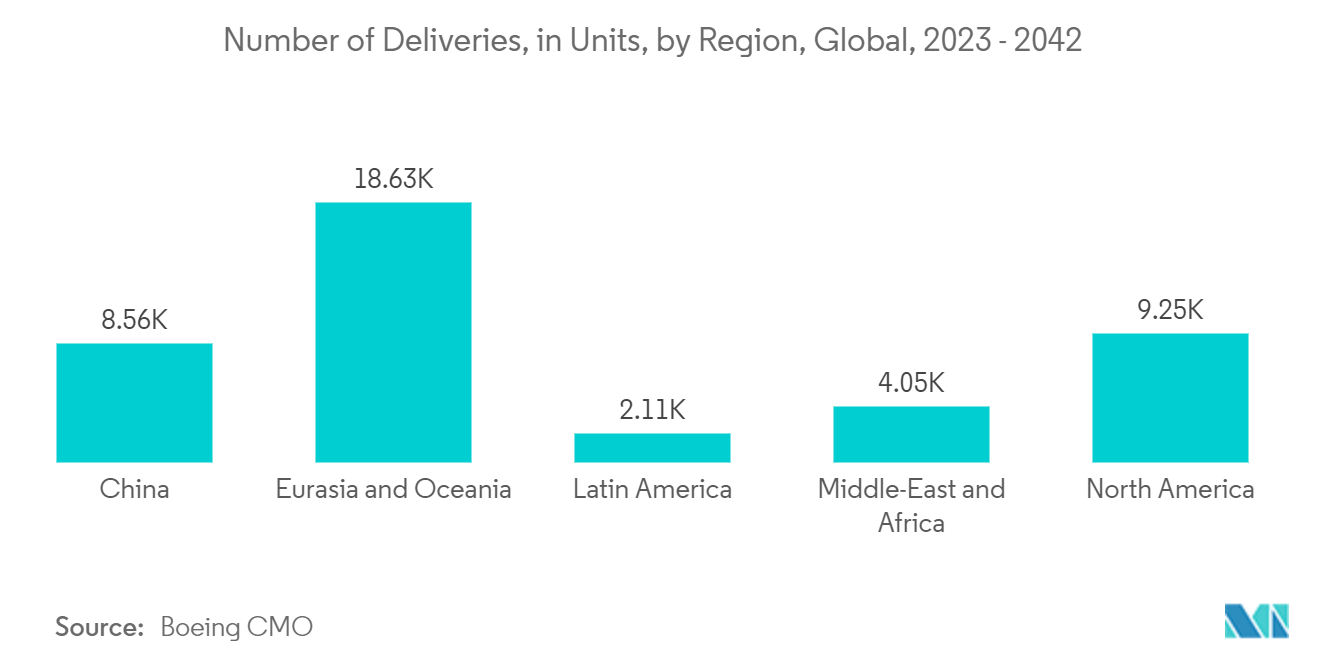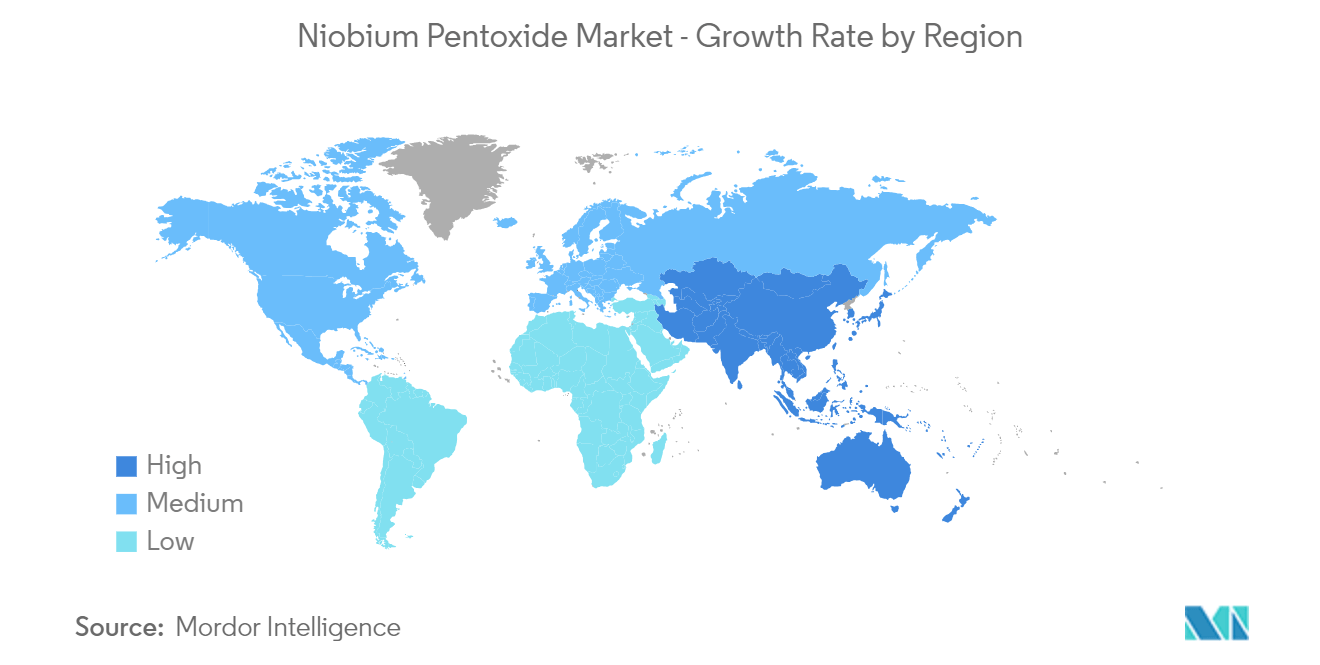Market Trends of Niobium Pentoxide Industry
Increasing Usage in the Production of Niobium Metal
- Niobium pentoxide, especially industrial grade, is used mainly in producing niobium metal. In addition, niobium pentoxide (99.9%) is also used to produce niobium metal for higher quality requirements. Technical quality niobium pentoxide (98-99%) is suitable for the electrothermic and metallothermic manufacture of niobium metal.
- Niobium metal offers high-temperature resistance, corrosion resistance, oxidation resistance, improved creep resistance, and reduced erosion at high temperatures.
- Niobium metal has good resistance to corrosive chemicals, even at high temperatures. It is, therefore, used to construct chemical equipment. Specifically, niobium metal plates, sheets, wires, rods, and tubings are used in sputtering targets, cathode protection systems for large steel structures, and chemical processing equipment. Moreover, it is also used for medical implants.
- According to the World Steel Association's latest short-term outlook, the global steel demand is estimated to drop by 2.3% year-on-year in 2022. However, it is expected to recover by 1% in 2023. The industry was hit by inflation, US monetary tightening, China's slowdown, and Russia's invasion of Ukraine, while high energy prices, rising interest rates, and declining confidence pushed demand forecasts down, leading to a slowdown in the steel manufacturing sector.
- Furthermore, according to the World Steel Association, the global steel production for January to July 2023 stood at 1,103.2 million tons, a decline of 0.1% compared to the previous year. This decline is majorly due to the 10.3% decline in European production. However, Asia-Pacific, Africa, and the Middle East registered a growth of 1.7%, 7.0%, and 2.3%, respectively, with a production capacity of 828.4 MT, 9 MT, and 26.2 MT in the first seven months of 2023.
- According to the Organisation Internationale des Constructeurs d'Automobiles(OICA), in 2022, around 85.01 million vehicles were produced across the world, witnessing a growth rate of 5.99% compared to 80.205 million vehicles in 2021, thereby indicating an increased demand for metal hoses from the automotive industry. In 2022, around 60 million passenger cars were manufactured worldwide, up nearly 7.35% compared to 2021.
- Recently, aircraft manufacturers have been looking for ways to accelerate production to fill order backlogs. For instance, according to the Boeing Commercial Outlook 2023-2042, the total global deliveries of new airplanes are estimated to be 42,595 by 2042. Owing to such huge expected deliveries, the demand for niobium pentoxide to produce niobium metal and alloys for aerospace is likely to rise globally.
- All factors mentioned above are likely to enhance the market's growth significantly.

The Asia Pacific Region is Expected to Dominate the Market
- China is the largest economy in terms of GDP in the Asia Pacific region. The country witnessed about 3% growth in its GDP in 2022, even after the trade disturbance caused due to its trade war with the United States.
- Niobium pentoxide and its derivatives find their key applications in iron and steel production. The strength of steel increases upon adding niobium to it. Moreover, niobium also improves the high-temperature oxidation resistance and corrosion resistance of steel, reduces its ductile-brittle transition temperature, and offers good welding properties and formability to steel. Specifically, niobium is used in the production of high-grade structural steel or high-strength low alloy (HSLA) steels and stainless steel.
- Niobium-based HSLA steels are mainly used in automotive and construction activities. Specifically, about 80% of all automotive sheet steel grades are regularly micro-alloyed with niobium. HSLA steels are used to manufacture fuel-efficient, safe, and long-lasting vehicles.
- According to the OICA (Organisation Internationale des Constructeurs d'Automobiles), automobile production and sales in China reached 27.021 million units and 26.864 million units in 2022, up by 3.4% and 2.1% from the previous year, respectively.
- The Chinese government is focusing on boosting investments across the construction sector in the country to boost overall economic growth. For instance, recent moves to increase financing for infrastructure construction include a USD 120 billion increase in the lending ratio of policy banks. The government is also considering allowing local governments to spend up to about USD 220 billion of the special bond quota, through which local governments fund infrastructure construction.
- Furthermore, India aims to become a USD 5 trillion economy by 2025. As a result, infrastructure development will play a critical role. The government has launched the National Infrastructure Pipeline (NIP) along with other initiatives, such as the Make in India and Production-Linked Incentives (PLI) schemes, to boost the growth of the infrastructure sector. Historically, more than 80% of the nation's infrastructure spending has been spent in the areas of transportation, power, water, and irrigation.
- Additionally, in construction, niobium alloys are used for producing structural and load-bearing parts. According to the Ministry of Land, Infrastructure, Transport, and Tourism (MLIT), Japan, in 2022, approximately 859.5 thousand housing developments were initiated in Japan, which represented an increase of 0.4% compared to the previous year.
- According to the Boeing Commercial Outlook 2023-2042, in China, around 8,560 new deliveries are projected to be made by 2042. Owing to such new deliveries in the country, the demand for niobium pentoxide from manufacturing aircraft components, especially engine blades, is likely to rise.
- Moreover, the aerospace industry in India is increasing significantly with the rising activities from the civil aviation sector. Many of India's aerospace manufacturing operations are anticipated to be carried out as a result of the rising demand for big aircraft from Indian carriers like SpiceJet and Indigo and the focus on Powered by Hour Contracts (PBH).
- According to the Stockholm International Peace Research Institute (SIPRI), Japan allocated USD 46.0 billion to its military in 2022, up 5.9% from 2021. Moreover, China's growing assertiveness in and around the South and the East China Seas has become a major driver of military spending in countries such as Japan.
- Due to the above-mentioned factors, the market for niobium pentoxide in the region is expected to have steady growth during the forecast period.


